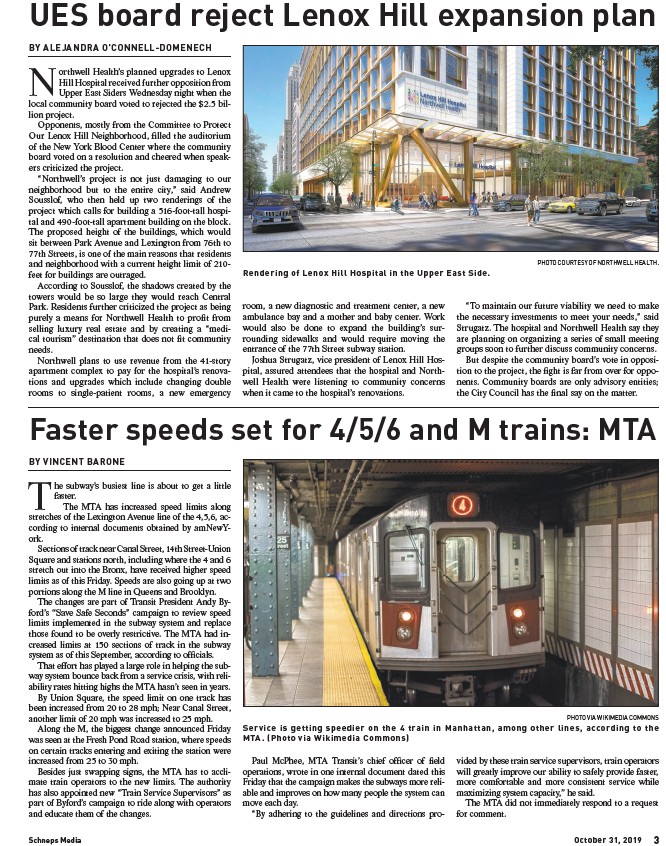
UES board reject Lenox Hill expansion plan
BY ALEJANDRA O'CONNELL-DOMENECH
Northwell Health’s planned upgrades to Lenox
Hill Hospital received further opposition from
Upper East Siders Wednesday night when the
local community board voted to rejected the $2.5 billion
project.
Opponents, mostly from the Committee to Protect
Our Lenox Hill Neighborhood, fi lled the auditorium
of the New York Blood Center where the community
board voted on a resolution and cheered when speakers
criticized the project.
“Northwell’s project is not just damaging to our
neighborhood but to the entire city,” said Andrew
Sousslof, who then held up two renderings of the
project which calls for building a 516-foot-tall hospital
and 490-foot-tall apartment building on the block.
The proposed height of the buildings, which would
sit between Park Avenue and Lexington from 76th to
77th Streets, is one of the main reasons that residents
and neighborhood with a current height limit of 210-
feet for buildings are outraged.
According to Sousslof, the shadows created by the
towers would be so large they would reach Central
Park. Residents further criticized the project as being
purely a means for Northwell Health to profi t from
selling luxury real estate and by creating a “medical
tourism” destination that does not fi t community
needs.
Northwell plans to use revenue from the 41-story
apartment complex to pay for the hospital’s renovations
and upgrades which include changing double
rooms to single-patient rooms, a new emergency
Rendering of Lenox Hill Hospital in the Upper East Side.
room, a new diagnostic and treatment center, a new
ambulance bay and a mother and baby center. Work
would also be done to expand the building’s surrounding
sidewalks and would require moving the
entrance of the 77th Street subway station.
Joshua Strugatz, vice president of Lenox Hill Hospital,
assured attendees that the hospital and Northwell
Health were listening to community concerns
when it came to the hospital’s renovations.
PHOTO COURTESY OF NORTHWELL HEALTH.
“To maintain our future viability we need to make
the necessary investments to meet your needs,” said
Strugatz. The hospital and Northwell Health say they
are planning on organizing a series of small meeting
groups soon to further discuss community concerns.
But despite the community board’s vote in opposition
to the project, the fi ght is far from over for opponents.
Community boards are only advisory entities;
the City Council has the fi nal say on the matter.
Faster speeds set for 4/5/6 and M trains: MTA
BY VINCENT BARONE
The subway’s busiest line is about to get a little
faster.
The MTA has increased speed limits along
stretches of the Lexington Avenue line of the 4,5,6, according
to internal documents obtained by amNewYork.
Sections of track near Canal Street, 14th Street-Union
Square and stations north, including where the 4 and 6
stretch out into the Bronx, have received higher speed
limits as of this Friday. Speeds are also going up at two
portions along the M line in Queens and Brooklyn.
The changes are part of Transit President Andy Byford’s
“Save Safe Seconds” campaign to review speed
limits implemented in the subway system and replace
those found to be overly restrictive. The MTA had increased
limits at 150 sections of track in the subway
system as of this September, according to offi cials.
That effort has played a large role in helping the subway
system bounce back from a service crisis, with reliability
rates hitting highs the MTA hasn’t seen in years.
By Union Square, the speed limit on one track has
been increased from 20 to 28 mph; Near Canal Street,
another limit of 20 mph was increased to 25 mph.
Along the M, the biggest change announced Friday
was seen at the Fresh Pond Road station, where speeds
on certain tracks entering and exiting the station were
increased from 25 to 30 mph.
Besides just swapping signs, the MTA has to acclimate
train operators to the new limits. The authority
has also appointed new “Train Service Supervisors” as
part of Byford’s campaign to ride along with operators
and educate them of the changes.
Service is getting speedier on the 4 train in Manhattan, among other lines, according to the
MTA. (Photo via Wikimedia Commons)
Paul McPhee, MTA Transit’s chief offi cer of fi eld
operations, wrote in one internal document dated this
Friday that the campaign makes the subways more reliable
and improves on how many people the system can
move each day.
“By adhering to the guidelines and directions provided
PHOTO VIA WIKIMEDIA COMMONS
by these train service supervisors, train operators
will greatly improve our ability to safely provide faster,
more comfortable and more consistent service while
maximizing system capacity,” he said.
The MTA did not immediately respond to a request
for comment.
Schneps Media October 31, 2019 3